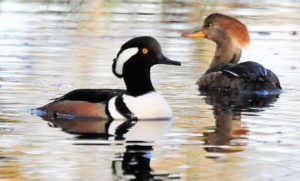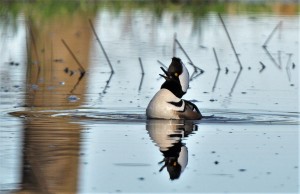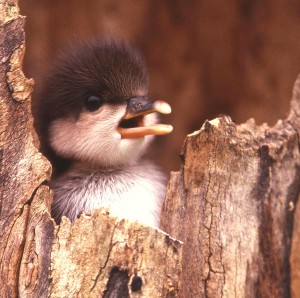Photography courtesy of Lowell Washburn, all rights reserved.
With its elegantly crested head and spectacular plumage, the wood duck is one of Iowa’s best known and most popular waterfowl. Most folks are also familiar with the woodie’s unusual woodpecker-like habit of nesting inside natural tree cavities or nest boxes instead of on the ground like other ducks.
Fewer, however, may be aware that another web-footed tree nesting duck species is currently making Iowa wetlands its home. That bird is the hooded merganser, and its numbers are on the rise. Although limited numbers of hooded mergansers are occurring statewide, they appear to be showing their greatest increases along the Mississippi river as well as along smaller streams and wooded backwaters in North Central. Mergansers are also increasing their use of artificial [wood duck] nest boxes, although it is likely that much of that use may be undetected. If the people who maintain boxes only look for hatched egg shells during spring maintenance, they may fail to realize that it was hooded mergansers, rather than wood ducks, who successfully occupied the nest.
The hooded merganser is an interesting bird, sharing many common traits with the more familiar wood duck. Like the wood duck, hoodeds live in two worlds; and inhabitant of both wood and water. As is the case with both species, males have elegantly crested heads and stunning plumage. Arriving in North Iowa shortly after ice out, merganser pairs quickly began scouring local woodlands for suitable nesting sites. While on the water, males conduct vigorous courtship displays which include crest flexing, head tossing, and guttural vocalizations that sound more like a frog than a bird. Within a day of hatch, the female calls her ducklings from the nest. At the first sound of her soft quirking, the fuzzy babies quickly appear at the cavity entrance then leap from the tree without hesitation, bouncing off the ground like fluffy cotton balls. Once the brood is collected, the hen hastily leads her ducklings to the water.
In addition to cavity nesting, hooded mergansers have other unique specializations that set them apart. Instead of the usual duck-shaped bill, mergansers have long and narrow, stiletto-like bills. Equipped with sharply serrated edges, it’s the reason the species is often referred to as “saw bill”. Instead of feeding on a variety of aquatic grains and acorns like the wood duck, mergansers dive beneath the surface where they catch and devour fish, crawdads, and tadpoles. The merganser’s eating habits have led to the common belief by hunters that they are inedible. I’ll state for the record that anyone who tells you that hooded mergansers taste like fish are admitting to you that they have never sampled one. While not exactly in the filet mignon category, hoodeds certainly are edible and, if they’ve spent a half day or so hanging in the smokehouse, the birds can be described as downright tasty.
For Iowa’s tree nesting ducks, the peak of this year’s hatch is underway. And regardless of whether the ducklings leaping from the nest turn out to be hoodies or woodies, they will both make beautiful and interesting additions to Iowa’s wild places.
LW






 Susan Judkins Josten
Susan Judkins Josten Rudi Roeslein
Rudi Roeslein Elyssa McFarland
Elyssa McFarland Mark Langgin
Mark Langgin Adam Janke
Adam Janke Joe Henry
Joe Henry Sue Wilkinson
Sue Wilkinson Tom Cope
Tom Cope Kristin Ashenbrenner
Kristin Ashenbrenner Joe Wilkinson
Joe Wilkinson Dr. Tammy Mildenstein
Dr. Tammy Mildenstein Sean McMahon
Sean McMahon